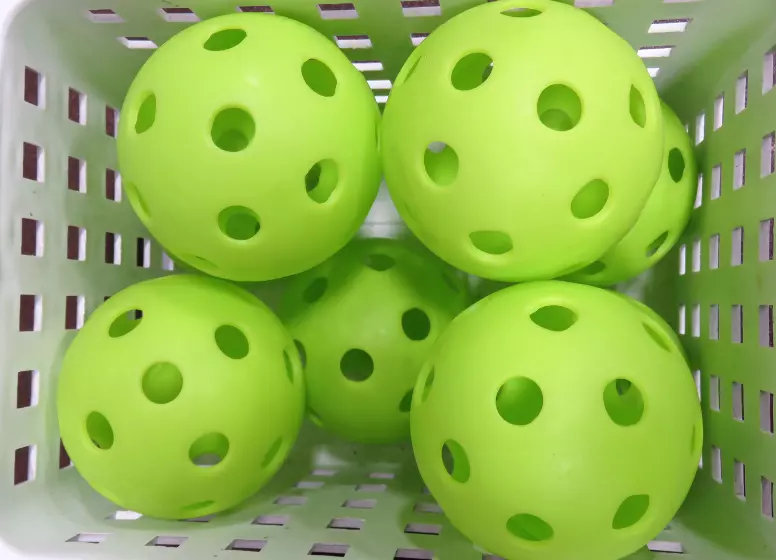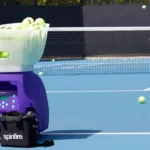Pickleball was first introduced in 1965 and has grown to become a national sport with 4.2 million players per year. In the next 10 years, the game will be played by over 80 million people.
There should be a diameter of 2.57-2.70 inches and a weight of 1.98-2.10 ounces on tennis balls. Playing pickleball requires a perforated plastic ball measuring 2 7/8 to 3 inches in diameter and weighing between 0.78 and 0.935 ounces, which is the color of official tennis balls. Official pickleball balls are optical yellow.
Unlike tennis, pickleball plays on an entirely different court size and uses a different type of racquet (a bat in Pickleball’s case). Ball size, weight, and flight characteristics differ between the games, as well as the ball size and weight.
How Pickleball Balls Differ From Tennis Balls

Various regulations govern the different sizes of balls that are used by different sports, and each sport must adhere to strict guidelines.
Specifications of permitted tennis balls
Unlike virtually every other sport that incorporates a ball in its play, tennis ball properties are very strictly specified by the governing body.
The Color Of A Tennis Ball
It is only relatively recently that tennis balls of official federations are colored optic yellow. Tennis balls used to be white until 1986.
Rubber-covered balls with pressurized air inside were developed first by the Indian Tennis Association. Black or white balls were often the first examples of these balls.
Due to the ease of seeing yellow and white on a television screen, the International Tennis Federation decided to allow only two-color tennis balls in 1976.
During Wimbledon 1986, only yellow balls were allowed to be used and all white balls were rejected.
You may enjoy reading How Long Do Tennis Balls Last?
The Construction Of A Tennis Ball
Two rubber shells are combined, and then a gas that is pressurized to 12 pounds per square inch is injected into the completed ball. Tennis balls with a higher air pressure have better bounce and spin characteristics while traveling faster.
A nylon or wool felt is tightly bound over the rubber shell. In addition to delaying air flow over the ball’s surface, the felt also reduces aerodynamic drag, which improves the flight characteristics of the ball.
After being dropped onto a concrete floor from a height of 100 inches, tennis balls must bounce between 53 inches and 58 inches high.
The Dimensions Of A Tennis Ball
The diameter of tennis balls must fall between 2.57 and 2.7 inches. By using the formula 2πr given at school to calculate the circumference, we can calculate the minimum circumference of a tennis ball by using 2*3.14*1.285 (half the diameter), which equals 8.0698 inches.
In a tennis ball, the maximum circumference is 2*3.14*1.35 (half the diameter) = 8.478 inches.
Tennis balls have an average circumference of 2*3.14*1.317 (half the diameter) = 8.2739 inches.
You may enjoy reading How To Make Tennis Balls Last Longer?
General Information About Tennis Balls
There is a limit to how long tennis balls will last after moderate play, which is 4 weeks.
A tennis ball’s bounce and firmness characteristics will diminish after two years, even if it hasn’t been opened or stored in the pressurized, sealed tube in which it was sold.
Specifications for permitted pickleball
USAPA (United States Of America Pickleball Association) has imposed strict specifications on Pickleball despite the game’s relatively short history.
The Color Of A Pickleball
In determining Pickleball’s colors, USAPA regulators have been very pragmatic.
Players can choose their colors, and there is no official requirement. Most players choose colors in accordance with their surroundings, and the optimum color contrasts with the surroundings and, therefore, is visible to them.
The Construction Of A Pickleball
A pickleball’s construction is similar to that of a Wiffle ball because it’s made from a smooth, durable material.
There must be between 26 and 40 circular holes in the surface of a pickleball ball.
It is possible for pickleball to have seams or ridges from the manufacturer, but they do not affect the flight or bounce characteristics of the ball.
After the ball is dropped 78 inches onto a granite surface, pickleball must have a bounce of 30 inches to 34 inches measured from the top of the ball.
The Dimensions Of A Pickleball
The diameter of the pickleball must be between 2 7/8 and 3 inches. A pickleball’s circumference is 2πr, which calculates the minimum circumference of a tennis ball as 2*3.14*1.39 (half the diameter) equals 8.0698 inches.
In tennis balls, the maximum circumference is 2.14*1.50* (half the diameter) = 9.42 inches.
A tennis ball has an average circumference of 2*3.14*1.445 (half the diameter) = 9.0746 inches.
When used on a Pickleball court, a durometer measuring surface hardness must score between 40 and 50 at a temperature of 75 to 80 degrees Fahrenheit.
You may enjoy reading How often are tennis balls changed at Wimbledon?
General Information About Pickleballs `
A Pickleball lasts about ten games before it cracks, not too dissimilar to a tennis ball.
There are different types of pickleball courts, including those outdoors and indoors. The “incorrect” ball will not provide the same satisfaction as the “correct” ball, whether the game is played indoors or outdoors.
There is a difference in the ball a player uses depending on whether they compete indoors or outdoors. Outdoor games in windy areas require an outdoor ball; otherwise, the game will be impossible to play.
What’s Next?
The equipment used in Pickleball has diverged quite a bit over the years, despite the sport’s strong influence on tennis. Tennis balls are half the size of Pickleballs but weigh twice as much, and bounce one and a half times as high as Pickleballs, even though they are within 10% of their size.
Players can now include both in their sporting accomplishments because they have developed into such distinct games.

![Pickleball Vs. Tennis Ball Size [2026 Updated] Pickleball Vs. Tennis Ball Size](https://tennispursuits.com/wp-content/uploads/2023/03/Pickleball-Vs.-Tennis-Ball-Size-768x554.webp)


Comments are closed.